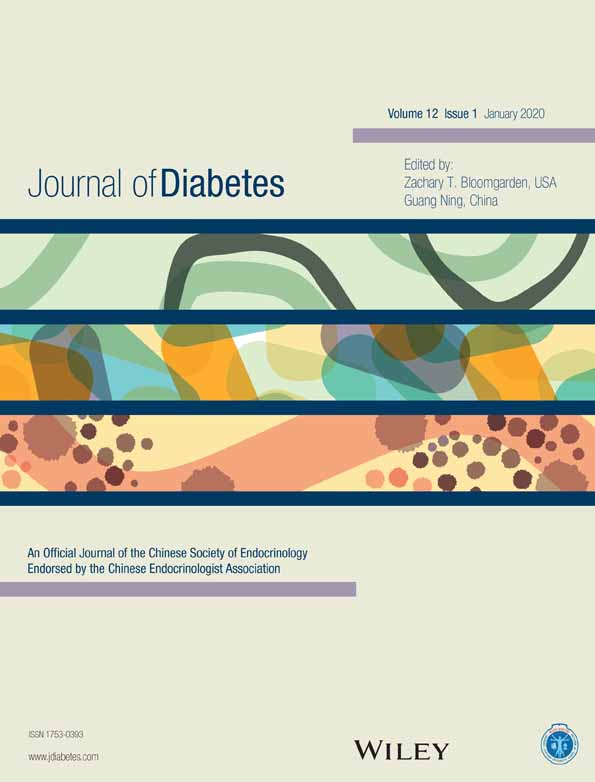A family in which people with a heterozygous ABCC8 gene mutation (p.Lys1385Gln) have progressed from hyperinsulinemic hypoglycemia to hyperglycemia
Mai Karatojima
First Department of Internal Medicine, Wakayama Medical University, Wakayama, Japan
Search for more papers by this authorCorresponding Author
Hiroto Furuta
First Department of Internal Medicine, Wakayama Medical University, Wakayama, Japan
Correspondence
Hiroto Furuta First Department of Internal Medicine, Wakayama Medical University, 811-1 Kimiidera, Wakayama, Wakayama 641-8509, Japan.
Email: [email protected]
Search for more papers by this authorNorihiko Matsutani
First Department of Internal Medicine, Wakayama Medical University, Wakayama, Japan
Search for more papers by this authorShohei Matsuno
First Department of Internal Medicine, Wakayama Medical University, Wakayama, Japan
Search for more papers by this authorShuhei Morita
First Department of Internal Medicine, Wakayama Medical University, Wakayama, Japan
Search for more papers by this authorShinsuke Uraki
First Department of Internal Medicine, Wakayama Medical University, Wakayama, Japan
Search for more papers by this authorAsako Doi
First Department of Internal Medicine, Wakayama Medical University, Wakayama, Japan
Search for more papers by this authorMachi Furuta
Clinical Laboratory Medicine, Wakayama Medical University, Wakayama, Japan
Search for more papers by this authorHiroshi Iwakura
First Department of Internal Medicine, Wakayama Medical University, Wakayama, Japan
Search for more papers by this authorHiroyuki Ariyasu
First Department of Internal Medicine, Wakayama Medical University, Wakayama, Japan
Search for more papers by this authorMasahiro Nishi
Department of Clinical Nutrition and Metabolism, Wakayama Medical University, Wakayama, Japan
Search for more papers by this authorTakashi Akamizu
First Department of Internal Medicine, Wakayama Medical University, Wakayama, Japan
Search for more papers by this authorMai Karatojima
First Department of Internal Medicine, Wakayama Medical University, Wakayama, Japan
Search for more papers by this authorCorresponding Author
Hiroto Furuta
First Department of Internal Medicine, Wakayama Medical University, Wakayama, Japan
Correspondence
Hiroto Furuta First Department of Internal Medicine, Wakayama Medical University, 811-1 Kimiidera, Wakayama, Wakayama 641-8509, Japan.
Email: [email protected]
Search for more papers by this authorNorihiko Matsutani
First Department of Internal Medicine, Wakayama Medical University, Wakayama, Japan
Search for more papers by this authorShohei Matsuno
First Department of Internal Medicine, Wakayama Medical University, Wakayama, Japan
Search for more papers by this authorShuhei Morita
First Department of Internal Medicine, Wakayama Medical University, Wakayama, Japan
Search for more papers by this authorShinsuke Uraki
First Department of Internal Medicine, Wakayama Medical University, Wakayama, Japan
Search for more papers by this authorAsako Doi
First Department of Internal Medicine, Wakayama Medical University, Wakayama, Japan
Search for more papers by this authorMachi Furuta
Clinical Laboratory Medicine, Wakayama Medical University, Wakayama, Japan
Search for more papers by this authorHiroshi Iwakura
First Department of Internal Medicine, Wakayama Medical University, Wakayama, Japan
Search for more papers by this authorHiroyuki Ariyasu
First Department of Internal Medicine, Wakayama Medical University, Wakayama, Japan
Search for more papers by this authorMasahiro Nishi
Department of Clinical Nutrition and Metabolism, Wakayama Medical University, Wakayama, Japan
Search for more papers by this authorTakashi Akamizu
First Department of Internal Medicine, Wakayama Medical University, Wakayama, Japan
Search for more papers by this authorFunding information: Japan Society for the Promotion of Science, Grant/Award Number: JP17K09842
Abstract
Highlights
- Inactivating mutations of the ABCC8 gene usually cause hyperinsulinemic hypoglycemia.
- We report a family in which people with the inactivating mutation have progressed hyperinsulinemic hypoglycemia to hyperglycemia.
- Treatment with incretin-related drugs might be a useful therapeutic approach to hyperglycemia in people with the inactivating mutation.
CONFLICT OF INTEREST
None declared.
REFERENCES
- 1Inagaki N, Gonoi T, JPt C, et al. Reconstitution of IKATP: an inward rectifier subunit plus the sulfonylurea receptor. Science. 1995; 270: 1166-1170.
- 2Naylor RN, Greeley SA, Bell GI, Philipson LH. Genetics and pathophysiology of neonatal diabetes mellitus. J Diabetes Investig. 2011; 2: 158-169.
- 3Yorifuji T, Horikawa R, Hasegawa T, et al. Clinical practice guidelines for congenital hyperinsulinism. Clin Pediatr Endocrinol. 2017; 26: 127-152.
- 4de Lonlay P, Fournet JC, Rahier J, et al. Somatic deletion of the imprinted 11p15 region in sporadic persistent hyperinsulinemic hypoglycemia of infancy is specific of focal adenomatous hyperplasia and endorses partial pancreatectomy. J Clin Invest. 1997; 100: 802-807.
- 5Kapoor RR, Flanagan SE, Arya VB, Shield JP, Ellard S, Hussain K. Clinical and molecular characterisation of 300 patients with congenital hyperinsulinism. Eur J Endocrinol. 2013; 168: 557-564.
- 6Huopio H, Otonkoski T, Vauhkonen I, Reimann F, Ashcroft FM, Laakso M. A new subtype of autosomal dominant diabetes attributable to a mutation in the gene for sulfonylurea receptor 1. Lancet. 2003; 361: 301-307.
- 7Kapoor RR, Flanagan SE, James CT, et al. Hyperinsulinaemic hypoglycaemia and diabetes mellitus due to dominant ABCC8/KCNJ11 mutations. Diabetologia. 2011; 54: 2575-2583.
- 8Ohkubo K, Nagashima M, Naito Y, et al. Genotypes of the pancreatic beta-cell K-ATP channel and clinical phenotypes of Japanese patients with persistent hyperinsulinaemic hypoglycaemia of infancy. Clin Endocrinol (Oxf). 2005; 62: 458-465.
- 9Matsuno S, Furuta H, Kosaka K, et al. Identification of a variant associated with early-onset diabetes in the intron of the insulin gene with exome sequencing. J Diabetes Investig. 2019; 10: 947-950.
- 10Li C, Ackermann AM, Boodhansingh KE, et al. Functional and metabolomic consequences of KATP channel inactivation in human islets. Diabetes. 2017; 66: 1901-1913.
- 11Kassem SA, Ariel I, Thornton PS, Scheimberg I, Glaser B. Beta-cell proliferation and apoptosis in the developing normal human pancreas and in hyperinsulinism of infancy. Diabetes. 2000; 49: 1325-1333.
- 12Shimomura K, Tusa M, Iberl M, et al. A mouse model of human hyperinsulinism produced by the E1506K mutation in the sulphonylurea receptor SUR1. Diabetes. 2013; 62: 3797-3806.
- 13Calabria AC, Li C, Gallagher PR, Stanley CA, De Leon DD. GLP-1 receptor antagonist exendin-(9-39) elevates fasting blood glucose levels in congenital hyperinsulinism owing to inactivating mutations in the ATP-sensitive K+ channel. Diabetes. 2012; 61: 2585-2591.
- 14Lu M, Li C. Nutrient sensing in pancreatic islets: lessons from congenital hyperinsulinism and monogenic diabetes. Ann N Y Acad Sci. 2018; 1411: 65-82.




